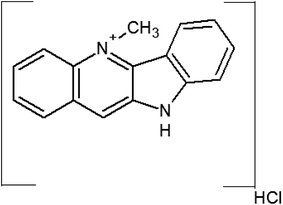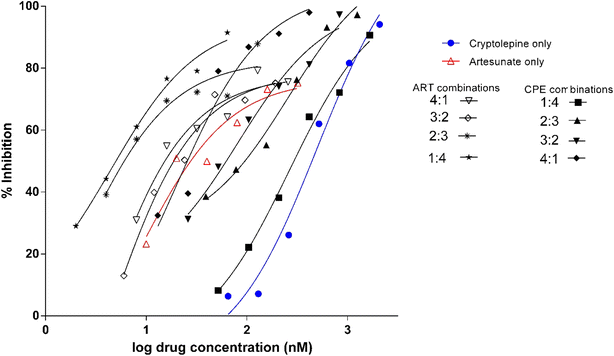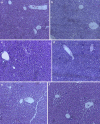Synergistic anti-malarial action of cryptolepine and artemisinins
- PMID: 26879905
- PMCID: PMC4754817
- DOI: 10.1186/s12936-016-1137-5
Synergistic anti-malarial action of cryptolepine and artemisinins
Erratum in
-
Erratum to: Synergistic anti-malarial action of cryptolepine and artemisinins.Malar J. 2016 Mar 16;15:171. doi: 10.1186/s12936-016-1223-8. Malar J. 2016. PMID: 26984022 Free PMC article. No abstract available.
Abstract
Background: Cryptolepine (CPE) is the major indoloquinoline isolated from the popular West African anti-malarial plant, Cryptolepis sanguinolenta. CPE possesses various pharmacological activities with potent anti-malarial activity against both chloroquine (CQ)-resistant and -sensitive strains. The search for safe and novel anti-malarial agents and combinations to delay resistance development to Plasmodium falciparum directed this work aimed at evaluating the anti-malarial interaction and safety of CPE in combination with some artemisinin derivatives.
Methods: The in vitro SYBR Green I, fluorescent-based, drug sensitivity assay using a fixed ratio method was carried out on the CQ-sensitive plasmodial strain 3D7 to develop isobolograms from three CPE-based combinations with some artemisinin derivatives. CPE and artesunate (ART) combinations were also evaluated using the Rane's test in ICR mice infected with Plasmodium berghei NK-65 strains in a fixed ratio combination (1:1) and fractions of their ED50s in order to determine the experimental ED50 (Zexp) of the co-administered compounds. Isobolograms were constructed to compare the Zexp to the Zadd.
Results: CPE exhibited promising synergistic interactions in vitro with ART, artemether and dihydroartemisinin. In vivo, CPE combination with ART again showed synergy as the Zexp was 1.02 ± 0.02, which was significantly less than the Zadd of 8.3 ± 0.31. The haematological, biochemical, organ/body weight ratio and histopathology indices in the rats treated with CPE at all doses (25, 50, 100 mg kg(-1) po) and in combination with ART (4 mg kg(-1)) showed no significant difference compared to the control group.
Conclusion: The combination of CPE with the artemisinin derivatives were safe in the rodent model and showed a synergistic anti-malarial activity in vivo and in vitro. This study supports the basis for the selection of CPE as a prospective lead compound as the search for new anti-malarial combinations continues.
Figures







Similar articles
-
Isobolographic analysis of co-administration of two plant-derived antiplasmodial drug candidates, cryptolepine and xylopic acid, in Plasmodium berghei.Malar J. 2018 Apr 4;17(1):153. doi: 10.1186/s12936-018-2283-8. Malar J. 2018. PMID: 29618354 Free PMC article.
-
In vitro anti-malarial interaction and gametocytocidal activity of cryptolepine.Malar J. 2017 Dec 28;16(1):496. doi: 10.1186/s12936-017-2142-z. Malar J. 2017. PMID: 29282057 Free PMC article.
-
Xylopic acid-amodiaquine and xylopic acid-artesunate combinations are effective in managing malaria in Plasmodium berghei-infected mice.Malar J. 2021 Feb 25;20(1):113. doi: 10.1186/s12936-021-03658-6. Malar J. 2021. PMID: 33632233 Free PMC article.
-
Recent developments in naturally derived antimalarials: cryptolepine analogues.J Pharm Pharmacol. 2007 Jun;59(6):899-904. doi: 10.1211/jpp.59.6.0017. J Pharm Pharmacol. 2007. PMID: 17637183 Review.
-
[Combined antimalarial therapy using artemisinin].Parassitologia. 2004 Jun;46(1-2):85-7. Parassitologia. 2004. PMID: 15305693 Review. Italian.
Cited by
-
Botanical Medicines Cryptolepis sanguinolenta, Artemisia annua, Scutellaria baicalensis, Polygonum cuspidatum, and Alchornea cordifolia Demonstrate Inhibitory Activity Against Babesia duncani.Front Cell Infect Microbiol. 2021 Mar 8;11:624745. doi: 10.3389/fcimb.2021.624745. eCollection 2021. Front Cell Infect Microbiol. 2021. PMID: 33763384 Free PMC article.
-
An overview of recent advances in duplex DNA recognition by small molecules.Beilstein J Org Chem. 2018 May 16;14:1051-1086. doi: 10.3762/bjoc.14.93. eCollection 2018. Beilstein J Org Chem. 2018. PMID: 29977379 Free PMC article. Review.
-
Indole: The After Next Scaffold of Antiplasmodial Agents?Drug Des Devel Ther. 2020 Nov 11;14:4855-4867. doi: 10.2147/DDDT.S278588. eCollection 2020. Drug Des Devel Ther. 2020. PMID: 33204071 Free PMC article. Review.
-
Identification of Commercial Antimalarial Herbal Drugs Using Laser-Induced Autofluorescence Technique and Multivariate Algorithms.J Fluoresc. 2024 Mar;34(2):855-864. doi: 10.1007/s10895-023-03309-w. Epub 2023 Jul 1. J Fluoresc. 2024. PMID: 37392364
-
Discovery of Antimalarial Drugs from Streptomycetes Metabolites Using a Metabolomic Approach.J Trop Med. 2017;2017:2189814. doi: 10.1155/2017/2189814. Epub 2017 Oct 16. J Trop Med. 2017. PMID: 29123551 Free PMC article. Review.
References
-
- WHO. World Malaria Report 2015. World Health Organization, Geneva: 2015. http://www.who.int/malaria/publications/world-malaria-report-2015/report....
-
- WHO. Status Report on Artemisinin and ACT Resistance. Geneva. http://www.who.int/malaria/publications/atoz/status-rep-artemisinin-act-....
-
- Khozirah S, Noor Rain A, Siti Najila MJ, Imiyabir Z, Madani L, Rodaya C, et al. In vitro antiplasmodial properties of selected plants of Sabah. Pertanika J Sci Technol. 2011;19:11–17.
-
- Basco LK, Le Bras J. In vitro susceptibility of Cambodian isolates of Plasmodium falciparum to halofantrine, pyronaridine and artemisinin derivatives. Ann Trop Med Parasitol. 1994;88:137–144. - PubMed
-
- WHO Severe Falciparum malaria. Trans R Soc Med Hyg. 2002;94:36–37.
MeSH terms
Substances
LinkOut - more resources
Full Text Sources
Other Literature Sources
Medical
Research Materials
Miscellaneous

